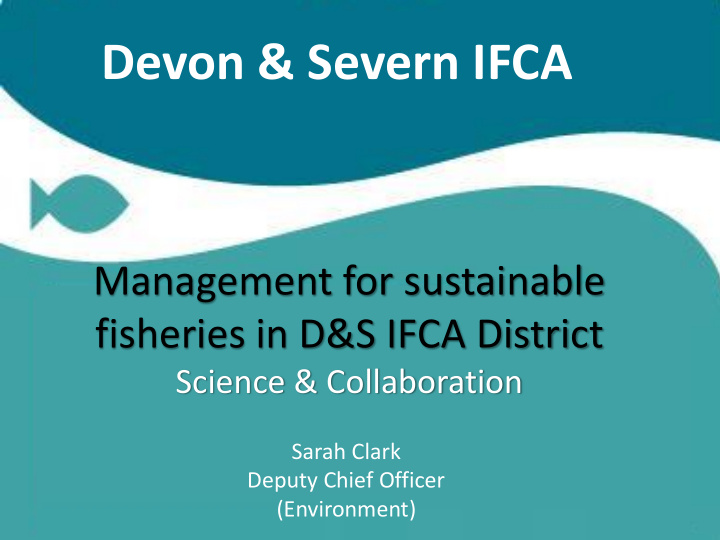



Devon & Severn IFCA Management for sustainable fisheries in D&S IFCA District Science & Collaboration Sarah Clark Deputy Chief Officer (Environment)
Managing the Whelk Fishery Determination of the Size of Maturity of the Whelk Collaboration with the fishing industry
Whelk fishery • Fishing effort for whelk shown rapid increase over the last decade • UK landings doubled between 2002 and 2012 o In 2002 8,687 tonnes landed worth £4 million o In 2012 16,000 tonnes landed worth £10.8 million • Often seen as ‘Boom and Bust’ fishery • Concern by industry members of impact of increased pressure on stocks and sustainability of fishery
D&S IFCA Whelk fishery • Main Devon landing ports are Ilfracombe, Exmouth and Brixham, although whelking occurs along the coast with smaller landings into other ports • 2016 figures show landings and values: Port Landing tonnes Value £000 Appledore 9.13 10.96 Bideford 60.74 73.94 North Devon Ilfracombe 533.40 640.88 Axmouth 22.66 24.47 Beer 1.12 0.99 Brixham 508.39 546.39 Dartmouth 38.13 38.84 South Devon Exmouth 302.22 328.08 Kingswear 35.04 34.96 Plymouth 0.31 0.34 Teignmouth 89.49 89.15
D&S IFCA Whelk fishery • For Ilfracombe and Exmouth the landings for 2012- 2016 can be seen below: Ilfracombe Exmouth tonnes Value £ tonnes Value £ 2012 661 479,000 241.8 170,599 2013 538 399,744 401 300,646 2014 716 564,646 301 238,605 2015 874 818,401 315 282,674 2016 533 640,877 302 328,080
Current Management • No quota • No closed season • EU Minimum Conservation Reference Size (MCRS) = 45mm shell height • D&S IFCA Potting Permit Byelaw • Lyme Bay Reserve Voluntary Code – 500 pots max – 30 pots per string max
Cefas Research • In order to investigate if this MCRS is sufficient to protect some of the spawning population Cefas carried out a study to give estimates of Size of Maturity (SOM) at main ports in England • The size of maturity (SOM) is the size at which the probability of an individual being mature is 0.5, i.e. the size at which 50% of the population is sexually mature. Location Female SOM (mm) Male SOM (mm) Exmouth 72.4 69.2 Ilfracombe 75.5 75.5
D&S IFCA Research Aims 1. Build on Cefas’ study to determine accurate estimates of SOM within District 2. Assess whether a Minimum Size based on shell width is viable (ease of sorting catch) 3. Identify peak breeding/spawning times
Industry Engagement • Meetings held with whelk fishermen in North & South Devon o Discussed how they see the fishery o General support shown for introduction of some additional management o Potential size increase / closed season • Two skippers volunteered to collect survey samples (Exmouth & Ilfracombe)
Methodology • Monthly samples collected from Exmouth & Ilfracombe for a period of 12 months • Size & sex stratified sub-samples analysed • Width, height metric data collected
Methodology • Assessing maturity stage a) b) Mature, yellow gonads Digestive whorl a) Immature female: no differentiation between digestive whorl and gonad. b) Mature female: gonad clearly differentiated from digestive whorl.
Methodology • Assessing maturity stage d) c) Digestive Mature, brick whorl red gonads Penis Penis c) Immature male: no differentiation between gonad and digestive whorl, undeveloped penis. d) Mature male: gonad differentiated from digestive whorl, penis fully developed.
Results Size of maturity by shell height - Exmouth: 50% 50% 69.3mm 70.9mm
Results Size of maturity by shell height - Ilfracombe: 50% 50% 76.4mm 76.5mm
Results • Strong positive correlation between shell height and shell width Size of maturity by shell width - Exmouth: 50% 50% 28.6mm 29.1mm
Results Size of maturity by shell width - Ilfracombe 50% 50% 31.7mm 31.5mm
Results Seasonality of reproductive cycle - Exmouth
Results Seasonality of reproductive cycle - Ilfracombe
Additional Samples • Discussed preliminary results with South Devon fishermen • Concern from industry that Start bay have smaller SOM • Extra samples collected from Start Bay by fisherman Size of Maturity by shell height: 50% 50% 57.8mm 64.4mm
Additional Samples Size of maturity by shell width: 50% 50% 25.9mm 28.2mm
Conclusions & Implications • 45mm shell height Minimum Conservation Reference Size is insufficient to protect spawning stocks • • recruitment over-fishing is likely to be occurring • Increasing MRCS will help the fishery to be more sustainable • A minimum size based on shell width might simplify the sorting of large catch quantities or be used for guidance to set riddle width • Potential for a closed season during times of peak reproductive activity • Potential introducing size and number of escape gaps
Management Proposals • IFCA proposing to increase Minimum Size by 5mm or 10mm increments over several years • Allows whelks to continue to grow year on year • Reduce impact on industry
Ongoing Work • Consultation has gone out to all Potting Permit Holders and interested parties – closing date 14 th March 2018 • Processors included in consultation • Consultation on the increase of MCRS over several years • IFCA welcomes information on economic impact of management changes from fishing industry • IFCA gathering more information on spawning season - filling gaps in data
IFCA & Industry concern for whelk stocks & Additional research Cefas research sustainability being undertake limited to one into look at sample per spawning season site IFCA met with Consultation fishing industry with fishing Science & to discuss industry on research project collaboration increase in and listen to MCRS thoughts & concerns Results show MCRS is not Samples sufficient to collected by protect spawning fishermen to stock and prevent under take recruitment SOM research overfishing
Recommend
More recommend